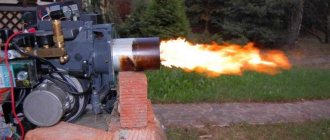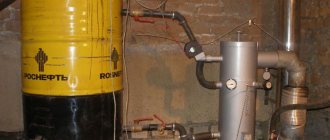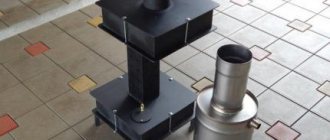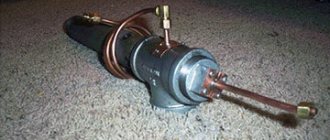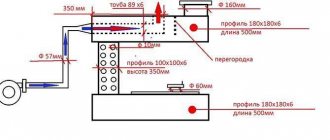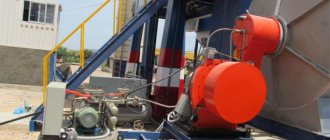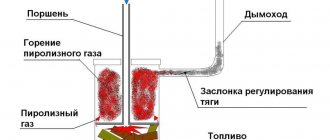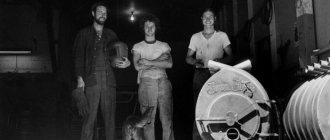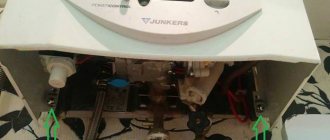- Waste oil burner based on the Babington principle
- Types of Russian-made waste oil burners
- The design of a finished burner operating on waste oil
- Filtration as the start of burner operation during production
- Warming up used oil before burning it
- Compressed air supply for waste oil recycling
- What is Babington's famous invention?
- Do-it-yourself burner: operating principle
- How to build your own apparatus based on the Babington burner principle: drawings
- Advantages and disadvantages of the Babington burner
- How to make a burner with your own hands according to diagrams and drawings
- Video: DIY oil burner
Waste oil burner based on the Babington principle
Many craftsmen in their practice are faced with the need for new devices, such as a waste oil burner. For owners of auto repair shops and garages, this will replace the furnace for heating the premises, especially if there are decent reserves of used oil and other fuel. Burners, if you understand the principle of their operation, can also be adapted for mixed fuel.
Using a waste oil burner, you can heat technical rooms.
Operating principle of waste oil burners
Liquid fuel burners are also called nozzles. Their work is based on the injection principle. That is, a strong air flow is created through the nozzle and a vacuum is formed in the fuel supply pipeline, due to which oil enters the combustion chamber and mixes it with air.
The efficient combustion of any liquid fuel depends on the intensity of its atomization. And the spraying efficiency depends on the special design of the nozzle and the pressure of the compressed air.
Fuel preparation
Before entering the burner, the fuel is filtered in a fuel filter and preheated in a special chamber. This is necessary to reduce the viscosity of the oil. For burning waste, preheating is 80-900C. The fuel preheating temperature is controlled automatically.
Diesel fuel does not require preheating, as it has sufficient fluidity.
Fuel supply
Fuel is pumped out of the tank by a fuel pump. It is collected from the surface of the flammable liquid surface. This is due to the fact that the waste may contain mechanical impurities or water, which settle at the bottom of the tank.
Combustion process
To maintain the combustion process, there must be a certain amount of oxygen in the combustion chamber. The air that is used to dilute and supply fuel is called primary air, and it supports the combustion process, but this is not enough.
An additional fan supplies secondary air. The intensity of the fan is regulated using a damper and participates in the operation of the automation system.
Ignition of fuel
To carry out automatic ignition of a liquid fuel boiler, an ignition transformer and electrodes are used. The fuel is mixed with a stream of air and sprayed into small droplets. After which it is fed into the combustion chamber and ignites under the influence of high temperature.
Types of Russian-made waste oil burners
During the cold season, not only residential but also auxiliary premises need heating. Currently, devices using different types of fuel are used for heating, including waste or waste technical oil. On the Russian market you can find devices that process different fuel bases, as well as having a narrow specialization. Based on the type of fuel burned, such devices are:
In terms of functionality, burners used for testing are not only heating, but also welding and lighting.
- gas;
- liquid fuel;
- combined.
The simplest and most economical device for heating a room is considered to be an exhaust burner. According to functionality, burners are divided into 3 subtypes:
- welding;
- lighting;
- heating.
The operating principle of these devices was borrowed from primitive kerosene gas back in the 50s. Quite quickly, the simplest burners became popular; they began to be purchased for heating country houses and garages. In those days, any fuel was inexpensive, but over time, zealous owners, inventors and innovators began to look for a replacement for gasoline, diesel fuel and kerosene. Fuel oil and waste oil were used, which are now used as full-fledged fuel. Today, the device is still relevant, and is also an excellent way to preserve the environment.
Note! In a room where any liquid fuel device will be used, be it a homemade gasoline burner, a working unit, or a DIY diesel fuel burner, there must be a fire extinguisher!
The types of burners used for processing are liquid fuel, gas and combined.
Making a waste oil burner with your own hands
Often, during seasonal oil changes in cars, problems arise with waste disposal. At the same time, many owners of personal plots would like to have a cheap source of heating for their home needs. A self-made waste oil burner helps solve both problems. Small investments in a simple project pay off in many years of savings on fuel. To save money, you can make a burner yourself
Operating principle and types of structures
Since any oil contains flammable substances, they can be burned. People have long been trying to make the most of this for their own benefit, but solving this problem is not so easy, especially if they try to burn used oil, which contains many additional components. There are three types of devices for this purpose:
- Ejection. Very effective system. Excellent fuel combustion, high temperature, low emissions, but it is almost impossible to do at home. In addition, not all fuels can be used without pre-treatment.
- Evaporative. The easiest to assemble from scrap material, but its effectiveness is low, there is a lot of waste and pollution. Additional equipment is required for ignition and smooth operation.
- Injection. The most acceptable option for making an oil burner with your own hands. Relatively simple design, easy to maintain, unpretentious to fuel. The main disadvantage is the inability to use in residential premises.
In this video you will learn how the burner works during mining:
Some craftsmen try to adapt blowtorches for heating by working off, but most often such endeavors result in complex alterations and a complete abandonment of the original burner design. The Babington oil burner has become most popular in recent years.
Robert Babington patented his invention at the end of the last century using one of Murphy's laws - to do everything in reverse. Robert did not spray the fuel by blowing it out of the nozzle, but simply tried to force air through the oil film . It produces an oily aerosol that burns beautifully. It’s not for nothing that they say that everything ingenious is simple.
A novice master can make such a burner if he has a garage or workshop with a bench vice and an electric drill. Having collected the necessary materials and prepared the tools, they make drawings of a waste oil burner or find ready-made ones on the Internet.
DIY making
Having collected everything you need in the garage, you begin the step-by-step assembly of the liquid fuel burner. Even an amateur can do it with his own hands . For the work you will need the following materials:
- Steel tee DN50 for two-inch pipes.
- Spherical nozzle head. Use brass door handles, ball nuts or similar parts.
- The nozzle is a steel tube with threaded ends. Length - 150−200 mm.
- Copper tube with a diameter of 10 mm for supplying fuel to the injector from the fuel tank.
- A metal tube with a diameter of at least 10 mm for the air duct.
- Threaded plugs for connections.
- Car or motorcycle fuel pump.
Don't forget about the materials we will need
Having collected all the necessary parts, proceed to assembly . To do this, follow the step-by-step instructions:
- A small hole of no more than 0.3 mm is made in the hemisphere of the future nozzle.
- Attach the air duct tube to the hemisphere.
- Insert the hemisphere inside the tee and screw in the sealed threaded plug.
- Make a hole in the nozzle to ignite the burner.
- Screw the nozzle drive to the body.
- A copper fuel pipe is screwed on top.
- The other end is inserted into the fuel tank.
- The tank is equipped with a heating element for heating the fuel to 70°C.
- The fuel supply tube is wrapped around the nozzle to heat the fuel while the burner is operating.
- A compressor is connected to pump air into the nozzle during testing.
This is how you make an excellent burner with your own hands according to the drawings. For more reliable and safe operation, the device is provided with measuring sensors and additional parts that will increase the efficiency of the device.
The design of a finished burner operating on waste oil
When purchasing gas burners and similar equipment, people are often interested in one or another element and its purpose in the overall design. For example, they want to know where the oil should flow from and where, how it ignites, and so on. When they think about how to make a burner at home, looking for a model for building a homemade analogue, even more questions arise. Most often people are interested in replacing injectors and oil containers with something suitable from available means.
Having at their disposal photos, diagrams and drawings of a waste oil burner, not every master will immediately get down to business. The main reason is the large number of specific details.
On a note! It doesn’t matter what the device is made of, the principle of operation of all burners is approximately the same: filtered and heated oil is supplied from the main container and burned in the combustion chamber.
The multicomponent process consists of several stages, and the success of its operation will depend on the quality of the components of the drip burner using waste oil with your own hands:
The operating principle of a burner operating on waste oil.
- extraction and filtration of waste;
- pumping and heating of purified oil;
- combustion process to produce heat.
Design of waste oil burners
The burner performs several functions: preparing and burning fuel.
Its design consists of several elements:
- fuel tank;
- fuel pump;
- fuel filter;
- burner (nozzle);
- compressor;
- connecting pipelines.
Read about the choice of material and installation of heated floors here.
You will find options for heating systems for baths at the link -
Find out how to choose the right automatic solid fuel boiler.
Filtration as the start of burner operation during production
Enterprises that produce finished devices operating on liquid fuel or waste are equipped with additional options that purify the oil. These are the so-called intake floats, which take the purest portion of the substance from the surface for heating. This principle of waste collection is currently inherent in the vast majority of manufactured products belonging to this category.
Next, through a hose made of material resistant to aggressive environments, used oil is supplied in portions. The tube is usually immersed approximately to the middle of the main container, so the solid suspension remains at the bottom, and a cleaner layer is used for heating and processing. At this stage, it is possible to filter the fuel quite efficiently without additional effort. Dirty impurities, sand and other insoluble components remain at the bottom.
Note! The duration of operation of a do-it-yourself waste oil burner nozzle largely depends on the purity of the fuel. Therefore, it is worth taking care of at least a rough cleaning of the oil fraction supplied to the firebox.
In order for the burner to operate for a long time, care must be taken to clean the fuel.
As you know, filters can be single-use or reusable. Sifting of coarse particles can be done through several layers or filter elements, like the ready-made heating pads from Smart Burner. The traditional equipment of different products is approximately the same: ready-made devices are rarely produced without a filter or elements replacing it.
A small transfer pump is a standard design part responsible for the uninterrupted flow of oil. If you organize the supply for a stationary unit according to the principle of communicating vessels, then in a homemade burner it can flow to the nozzle by gravity.
Warming up used oil before burning it
An equally important stage in preparing the device for operation is heating the used oil before complete combustion to release heat. When heated, the oil becomes more liquid and plastic, resulting in an optimal consistency that burns well.
A preheating tank or heating coil is needed for any do-it-yourself waste oil burner - the drawings show an intermediate location. Usually this is a separate chamber or capsule of small volume, hidden in the middle of the body. The purpose is to warm up the fuel as efficiently as possible before the combustion process. Finished products most often have a temperature relay that monitors the heating level. As a rule, they operate in an operating range of 0-150 °C.
Some burner models are equipped with an electric heating element for heating the oil.
Note! Burners adapted for combined suspensions usually have a container for heating. Diesel fuel in homemade diesel burners does not require heating.
Manufacturers decide differently how to organize this stage. The Gnome waste oil burner (and other similar models) has a small electric heating element inside the container, which is responsible for heating the waste oil to the required level. Just as in this case, each manufacturer decides in its own way the issue of oil supply. Often float switches and pumps are responsible for the level of its supply. The system switches off automatically when the preheating tank is full.
Types of waste oil burners
The operating principle of traditional liquid fuel burners is almost the same; they differ only in design features, level of automation, power and efficiency.
There are modified types of burners:
- burners with preliminary fuel gasification;
- evaporative burners.
Some liquid fuel burners combine all the elements in their design: pump, filter, heating chamber and compressor. Such models save space and do not require the installation of additional equipment.
All burners can be divided by operating mode:
- single-stage burners can only operate in one mode;
- two-stage ones are capable of operating at 40% of their power and at 100%, that is, they have 2 modes;
- modulating burners operate in a wide power range: from 10 to 100%.
Compressed air supply for waste oil recycling
Compressed air is required to prepare the oil mixture for combustion by atomizing it. This transport is directed to the nozzle, which is carried out under pressure. Due to the supply of oxygen through a separate channel, it ensures the combustion process in any device, including a DIY Babington burner using waste oil. Although the device was initially patented as running on diesel fuel, it was also adapted to run on technical oil.
Successful air supply requires a mini-compressor built into ready-made liquid fuel devices. It can be transported in other ways, for example, using the pneumatic principle. If there is no compressed air, the nozzle may not work correctly.
Compressed air in the burner is necessary to prepare the oil for combustion.
On a note! A small pressure gauge helps monitor the operating pressure, thereby maintaining the parameters necessary for full operation of the entire device.
Air flow regulation is provided by a special solenoid valve on the housing. Expensive equipment also includes air filters to purify the air. They will be useful in dusty mini-workshops, boiler rooms or other rooms where the air taken for the combustion process has many impurities. To operate a burner nozzle using waste oil yourself, you need an adjustable secondary air supply. The following burner parts are responsible for the synchronous operation of all components:
- nozzle (nozzle);
- fuel compartment;
- heating tank;
- air supply valve;
- oil supply regulator;
- a pressure gauge for checking pressure (there may not be one);
- blower (fan).
In finished devices, ignition is provided by electrodes. Compressed air is supplied through the air channel, from where it enters the nozzle. After heating, the used oil also goes there. If the nozzle is clean, it produces high-quality ignition of the fuel, which implies the appearance of an even, continuous flame.
Each exhaust burner must be equipped with an air supply valve.
Waste oil burner flame
In order to achieve an effective result when operating a burner using waste oil and burning waste, you must follow the rules and recommendations specified in the instructions for your equipment. First start-up of the waste oil burner. As a rule, the main requirements before the first start-up of equipment are as follows: - the fuel must be of high quality and prepared; — the settings of the primary and secondary air must be observed and set in accordance with the equipment passport; — used oil must be well heated; - the gap between the electrodes must be observed and set according to the instructions: - the chimney must be correctly folded (good stable draft);
As for the quality of the fuel, it should be as purified as possible, without containing water, impurities and antifreeze. The ideal option is pre-filtration. Also, the oil must be heated to a certain temperature - this is achieved using a built-in heater or a preheating tank, depending on the burner manufacturer.
For proper ignition during the initial start-up of a burner using waste oil, the so-called damper (or regulator) for the air supply to the burner (secondary air) must be correctly adjusted, because it largely determines whether the start will occur. We do not recommend starting the equipment with the damper maximally open or completely closed - most likely the burner device will either not work, or will work, but not correctly, and will soon go into emergency mode.
Set up your equipment based on preliminary data on primary and secondary air - this is guaranteed to allow you to start. Well, after launch, you can always make more precise and sophisticated settings.
As for the gap between the electrodes and the flame-holding head, again, see the instructions. Yes, at the factory the gaps are set to the required positions, but during transportation these settings may still be lost. In addition, the gaps must be checked and adjusted when replacing spare parts - nozzles, electrodes and retaining washer.
Checking the length and oval of the flame.
To adjust the flame, always use the inspection window, which is provided by all manufacturers of waste oil burners. In this case, be careful, since the hole itself may be hot, which will lead to burns - maintain a distance of at least half a meter from the window. The flame can be increased or decreased by supplying primary air, while adjusting the secondary air and adjusting the air suction.
Manufacturers' recommendations, for the most part, indicate that the flame should occupy from half to two-thirds of the combustion chamber. That is, it should not “lick” the back wall of the combustion chamber - this may lead to its premature failure.
The flame itself should not have a bright orange color, but should be white-yellow, straw in color, not sparkle, and have pointed flames.
An example based on Clean Burn waste oil air heaters.
Correct flame. Very good location in the combustion chamber (there is enough air and fuel pressure). It is distributed throughout the entire volume without touching the surface.
Incorrect flame (too much or too little air pressure)
If you see black smoke coming out of the chimney, this indicates that there is a shortage of combustion air. The damper needs to be adjusted again. At the same time, yellow-brown spots in the form of dust on the chimney are correct - this is all due to the presence of non-combustible particles in the fuel. And the absence of black, dark gray and orange-brown soot on the chimney indicates excellent, complete combustion.
Here are the main points that affect the quality of the flame in a boiler or heat generator. Of course, other parameters also influence, such as the configuration of the combustion chamber of the thermal unit, the origin of the used oil (its nature), but these points are perhaps the key ones. So pay attention to them!
No part of this article may be reproduced in any form or by any means, electronic or mechanical, or published on the Internet without the written permission of the copyright owner. © ThermoAlliance, 2016.
What is Babington's famous invention?
Every invention has its own author, even if his name is undeservedly forgotten by his descendants. For example, in 1969, British inventor Robert Babington received a patent for a stove running on diesel fuel, which was reminiscent of lighting kerosene gas operating on kerosene vapor. Robert Babington's design was originally designed for kerosene, then it was adapted for diesel fuel. When the number of cars increased disproportionately, the used oil had to be disposed of somehow. Therefore, innovators were looking for devices suitable for these purposes.
First, based on the patented invention of R. Babington, a do-it-yourself diesel burner appeared, then it was adapted for burning oil and other types of fuel. The testing device appeared much later than the diesel design, but it surpassed its predecessor in popularity and safety.
After some time, a similar device was proposed again, since the first patent had expired, and the liquid fuel stove had not lost its relevance. Similar devices were repeated in different versions, and not only self-taught craftsmen, but also design bureaus of reputable enterprises tried to assemble the Babington burner with their own hands.
By design, the burner is a simple device, so it can be successfully manufactured at home. It is characterized by fairly high efficiency in terms of obtaining the heat necessary for heating:
Burner diagram based on the Babington principle, where 1 – heating sensor; 2 – casing; 3 – heat exchanger; 4 – fuel sprayer; 5 – glow plug; 6 – supercharger; 7 – fuel pump; 8 – friction clutch; 9 – electric motor; 10 – lever for switching operating modes; 11 – fan; 12 – skeleton; 13 – fuel pipe; 14 – combustion chamber.
- technological installations;
- small workshops;
- workshops;
- garages;
- warehouse and utility rooms.
On a note! You should not adapt a homemade burner with your own hands for heating your home, since burnt oil has a specific smell.
How to make a Babington burner
The idea of using waste oil as an energy carrier to heat buildings is not new. Due to the large amount of waste at vehicle service stations, especially trucks, a problem arose with its disposal.
It is not surprising that various units, both factory-made and home-made, have appeared that make it possible to effectively burn this substance and receive thermal energy from it.
One of such devices is a Babington waste oil burner, we will look at it in this material, and also tell you how you can make it yourself.
What is a Babington burner?
The diesel burner design was patented by Robert Babington in 1979. However, the patent expired, after which all information about the device and operating principle of the unit became publicly available, as did the drawings of the Babington burner. As a result, many craftsmen were able to repeat this design, only instead of diesel fuel they used used automobile oil, and later other types of liquid oils.
It is not easy to effectively burn old oils, since waste from the same car service is a mixture of oils of various viscosities with a large number of impurities. It also contains gasoline, diesel fuel and even antifreeze in small proportions. All these points are taken into account by the design of factory-made burners; filter elements are built into them.
Another thing is the Babington burner; no filtering is required for its operation, and here’s why. The fuel flows down the spherical surface, forming a thin film, and a small hole (0.1-0.3 mm in diameter) is made in the center of this sphere to supply air under pressure. The basic principle of operation of the burner during extraction is that the air escaping from the hole breaks off part of the oil flowing down the surface. The result is a torch of air-fuel mixture capable of ignition.
The amount of dirt in the exhaust only affects the combustion efficiency; the burner operates on exhaust and is not clogged with impurities suspended in it, since there are no narrow passages or holes with small diameters in the fuel path, as in nozzles. There is only one hole here, only air passes through it. Instead of a complex filtration system, the waste oil burner design provides for the supply of fuel to a spherical surface, and its excess that does not enter the torch flows down into the sump.
An indispensable condition for high-quality combustion is preheating of old oils. This is necessary for 2 reasons:
- Increased turnover. Thanks to this, the substance covers the surface of the sphere well and, when air is supplied, is better atomized, forming a stable aerosol plume.
- Reduced flash point. Using heated oil, it is easier to ignite the Babington burner, and during operation it makes maximum use of the fuel energy, releasing more heat.
How this burner functions is clearly shown in the video:
What is the difference between a blowtorch and a Babington burner?
The operation of a supercharged torch is often compared to the combustion of the well-known blowtorch. Indeed, their structure has certain similarities. But the principle of operation is completely different.
In a blowtorch, gasoline in a closed container is exposed to excess air pressure created by a hand pump. This air does not mix with the fuel, but only pushes it upward, towards the nozzle.
Along the way, the gasoline warms up and evaporates in the pipe casing, after which it enters the injector nozzle. Coming out of it, the fuel mixes with air and burns, forming a powerful torch of flame.
Everything happens the other way around in a vertical Babington burner during processing. Air, not fuel, is blown through the nozzle, while the contaminated oil does not evaporate, but is only heated to a certain temperature (no more than 70 ºC).
In this case, the liquid does not burn completely; part of it goes into the sump. Due to the fact that it is extremely difficult to evaporate the waste and feed it through the nozzle into the combustion zone, it is not possible to make a burner using the waste from a blowtorch.
Just like filling a Babington unit with gasoline, this is not only ineffective, but also downright dangerous.
Advantages and disadvantages
The main advantage due to which the homemade burner at the Babington mine has gained wide popularity is its omnivorous nature, as mentioned above. In fact, you can pour any heated oil of a reasonable degree of contamination onto a spherical surface, and a properly made burner will still operate stably.
It is not afraid of gasoline or antifreeze impurities, unless their ratio with oil is one to one, then problems will inevitably arise. And then, this is not at all a reason to get rid of such a mixture; for the burner to function normally using waste oil, it will need to be well diluted with the “correct” treatment, and then put into use.
Another advantage is the simplicity of the design, which is why craftsmen quickly mastered this product. Indeed, making the “heart” of the device from a ball or hemisphere placed in a body is quite simple. It is somewhat more difficult to organize the fuel supply and air injection, and even to configure the entire system so that the DIY Babington burner operates stably and safely. But there is wide scope for the implementation of various technical solutions.
Of the serious shortcomings of the unit, only one is striking. This is the constant presence of dirt in the room where the liquid fuel burner operates. Unfortunately, it is impossible to completely eliminate accidental spills or seepage of contaminated machine oil through leaks, even if all connections are sealed and an automatic Babington burner is installed. To one degree or another, the room will be dirty, you will have to come to terms with it.
Manufacturing recommendations
Due to its popularity and simplicity, the burner for the waste boiler is made by craftsmen in different variations, but we will undertake to describe the simplest design, which will be available for repetition at home. First you need to select the necessary materials, here is their list:
- Steel tee with internal threads with a diameter of 50 mm - for the body.
- Squeegee with external thread with a diameter of 50 mm - for the nozzle. Its length is optional, but not less than 100 mm for the nozzle.
- Metal elbow DN10 with external threads - for connecting the fuel line.
- Copper tube DU10 of the required length, but not less than 1 m - to the fuel line.
- A metal ball or hemisphere that fits freely into the tee is for the working part.
- A steel tube of at least DN10 is used to connect the air duct.
Do-it-yourself burner: operating principle
If you look at photos, pictures and drawings, it becomes obvious that the secondary oil forms a thin film on a curved surface. Through a groove, gas or air is supplied into the container under low pressure. After heating, the oil is atomized by this air flow, ensuring high-quality ignition.
It was this method of ignition that became the basis for inventions that have become widespread in homemade devices and drip burners using waste oil, produced in factories. Used oil is essentially free fuel, a used suspension. Therefore, it is considered more advantageous compared to other heat sources:
You can make a waste oil burner yourself.
- solid fuel and briquettes for a homemade pellet burner;
- gasoline and diesel fuel;
- electricity;
- natural gas;
- kerosene;
- fuel oil.
On a note! Although waste remains the cheapest basis for releasing heat during disposal through combustion, it is still recommended to prepare oil clogged with impurities - to allow the water to settle and filter it from heavy suspended matter.
The first devices using kerosene, diesel fuel and oil smoked heavily and emitted an unpleasant odor. Later they offered a do-it-yourself gasoline burner and devices using other combustible raw materials, but an active search was underway for budget fuel. Oil turned out to be a suitable source of heat, but the soot and smell negated all the benefits. Therefore, all the efforts of the inventors went into eliminating these disadvantages of the burner for waste oil boilers. This should have been facilitated by complete combustion, heating and filtration of contaminated fuel.
Advantages of waste oil burners
This device, in addition to its main purpose in the form of efficient conversion of fuel into thermal energy, is additionally considered as a method of useful disposal of waste unsuitable for further use. The word “working out” means the following:
- Lubricants (oils).
- Medium and light heating oils, as well as some types of heavy ones.
- Used semi-synthetic, mineral and synthetic oils.
- Fat of vegetable and animal origin.
- Diesel fuel of any quality.
- Vegetable oils (rapeseed or general oils).
The listed materials have sufficient energy potential. Considering that the cost of processing is meager (used oil is often given away for free), it is impossible to find a similar energy carrier without financial costs.
When using motor oils, various impurities get into it. Therefore, the waste is always contaminated. Also, the very specificity of the material implies the ability to envelop rubbing parts with a thin layer - the work is sticky. Comparing the listed facts, it is easy to guess that a conventional burner cannot use such fuel. This is where the features of the waste oil burner design lie:
- Immunity to fuel contamination by solid debris.
- Insensitivity to water content in mining (ingressed antifreeze or water).
- Presence of heating (dirty fuel has a high viscosity, which will prevent the air from forming the desired mixture).
- A device capable of handling the ignition of thick fog (a mixture of dirty fuel and oxygen).
Specific fuel (exhaust) imposes restrictions on the scope of application of the burner. Due to contamination, the waste cannot be used for heating residential buildings. Technical rooms in the form of a boiler room in a private house, or utility rooms (workshop, garage, etc.) are perfect.
How to build your own apparatus based on the Babington burner principle: drawings
The principle of operation of a homemade burner, made based on the idea of Robert Babington, is clear from the drawings, where the components of the unit are visible:
Drawing of a waste oil burner according to Babington.
- waste oil tank;
- waste tray;
- fuel supply pipe;
- a small fuel pump for supplying portions of oil;
- hemisphere for spraying with a small hole;
- heating chamber with heating element (may be missing).
On a note! The testing nozzle is not a mandatory element for organizing the smooth combustion process. It can be successfully replaced by a nozzle - a small hole for supplying an air stream and fuel. To ensure that it does not become clogged, its serviceability must be monitored.
The used oil evaporates and flows down the hemisphere. These oily vapors are mixed with the air mass, resulting in a fuel mixture. The remaining oil that has not had time to be utilized flows into the pan, and from there through the tube back into the fuel tank.
This unit, based on Babington's patent, designed to burn liquid fuel, is quite simple. Therefore, it can be reproduced from scrap parts in a home workshop. Success depends on the exact compliance of the parts with their intended purpose and on the coordinated operation of all components. Therefore, before making a burner with your own hands, you should carefully calculate all the parameters.
The design of the burner is quite simple, so it can be made from available materials.
On a note! If you take one option as a basis, for example, the Gnome burner, using ready-made drawings and recommendations from craftsmen, it is difficult to make a mistake in the size and functionality of the parts.
Advantages and disadvantages of the Babington burner
Each technical device has a number of useful qualities and shortcomings. Obviously, this device has more pros than cons. The main advantage is the utilization of waste raw materials for the greatest benefit. Other advantages of oil and liquid fuel recycling equipment:
- burning waste helps preserve the environment;
- ease of operation and high energy efficiency;
- manufacturing of the device is possible under normal household conditions;
- obtaining heat at a minimum cost of raw materials;
- simple design manufacturing scheme, clear drawings;
- a homemade apparatus can be made from available materials;
- use in workshops and enterprises where a lot of processed raw materials accumulate that require disposal;
- the small dimensions of the burner allow it to be moved if necessary;
- waste and the lowest-grade oil go into the furnace;
- device functionality;
- relative fire safety;
- reuse of used oil.
The main advantage of the burner is the beneficial disposal of used oil.
Flaws:
- It is not recommended for use in cottages and residential premises due to burning and odor;
- the need to equip the premises with a fire extinguisher;
- It is imperative to follow all recommendations for the manufacture of the burner;
- the nozzle or nozzle should be checked periodically (if the holes are clogged with solid particles);
- sensitivity of the nozzle or nozzle to contamination;
- additional power supply to the components of the device (pump, compressor).
How to make a burner with your own hands according to diagrams and drawings
The burners, based on the invention of Robert Babington, have undergone repeated refinement and modernization. Hence the discrepancies in different drawings, diagrams and illustrations. The chosen option needs careful study to eliminate design errors.
On a note! You should not make an average version of the burner for recycling waste oil. It is better to use one proven device based on the proposal of an experienced innovator.
Burner assembly diagram, where 1 – fuel intake; 2 - fuel pump; 3 – fuel filter; 4 – burner; 5 – compressor; 6 – air compressor hose; 7 - fuel hose; 8 – fuel line.
Hints and recommendations from other craftsmen may also be useful for making certain elements and units. The proposed explanations, which were taken from one of the specialized forums, concern the following details:
- a metal hemisphere (can be made from anything, including part of a brass door handle or a spherical nut);
- a steel threaded tee for connecting two-inch pipes (instead you can take a cross with the same parameters);
- a 10 mm copper tube is suitable for fuel supply;
- for the nozzle you need a metal pipe bend with an external thread (up to 200 mm);
- for air supply, a metal tube with a diameter of 10 mm, connected to the nozzle, is useful;
- It is better to connect the channels to the body using threaded fittings of a suitable size;
- The main supply of waste will be carried out by a small pump with a simple motor (from a motorcycle or car).
On a note! It is recommended to use a compressor from a refrigerator. A small pressure (2-4 bar) will be enough for the nozzle to work effectively. Ignition is easily ensured by spark plugs from the car, standing at the nozzle.
To avoid mistakes when assembling the burner, you must carefully study the instructions and diagrams.
The nozzle is a small hole; its size regulates the power of the homemade product according to R. Babington’s principle. Sometimes several small holes are made in the hemisphere, since one may become clogged or it will not be enough. There is information that 1 hole measuring 0.25 mm will provide a burner power of 10-15 kW, which depends on the quality of the combusted raw materials.
In a hemisphere with a finished hole, an air supply channel is attached through an inlet through a tee. The tightness is ensured by a threaded plug in which a groove for the tube is drilled. The tee should be soldered to the fitting where the oil supply tube is connected, which requires heating before disposal. To do this, you need to solder a heating element into the tank, preferably with a thermal relay. A tube with several turns will prepare waste oil for feeding into the nozzle.
In order for air to flow in, you additionally need to drill 2 grooves about 8 mm in size in the nozzle. First, a nozzle is attached to the tee, then a copper spiral tube is attached, after which it is attached to the fitting. Some of the oil will drain into the settling tank, which, for safety, is best directed to the side through a tube. Masters who know the secrets of electronics usually provide the device with a controller and a board for organizing ignition.
The burner is a universal design that can be adapted for other types of liquid fuel. Although such devices are on sale today, their high cost encourages home craftsmen to do something similar with their own hands. In terms of efficiency, home appliances for burning waste are not inferior to branded new products designed for heating mini-workshops, greenhouses, and small farms.
DIY waste oil burner. How to make a waste oil burner
page » Publications » DIY waste oil burner. How to make a waste oil burner
Constantly rising prices for traditional fuel force owners of private houses to look for alternatives to gas, wood or fuel oil. One such source could be the disposal of used oil, which accumulates millions of tons per year.
Waste oils include not only motor oils that are changed at car repair shops, but also machine oils used for industrial units, and vegetable oils from food industry enterprises. Burning them can have a good effect both economically and environmentally. We also want to tell you that there are gas burners.
One of the leading manufacturers of such burners is the Italian company R. You can find out more about fbr gas burners, as well as buy one for yourself at https://fbr.ru.
It is almost impossible to operate a conventional boiler, which is designed to burn gas, fuel oil or diesel fuel using waste oil. The problem is the fuel itself. Unlike gas or diesel fuel, oil is very difficult to set on fire. The second problem is the purity of the fuel itself.
Oil used in internal combustion engines often contains gasoline or coolant impurities, which makes it much more difficult to ignite. For testing, a special burner design is required.
Learn how to make a waste oil burner with your own hands later in the article.
Operating principle of waste oil burner
A conventional nozzle, which is installed in a gas or liquid heating boiler, works as follows:
- The fuel, if it is fuel oil or diesel fuel, is pumped into a special tank, where it is preheated using the heat from the operation of the boiler.
- A pump then forces high-pressure fuel into the injector, which has a very narrow outlet.
- Thanks to the nozzle, fuel is injected in the form of a mist, which is highly flammable.
When used oil is used in such a scheme, a conventional nozzle often becomes clogged, and the oil burns very poorly.
The solution to this problem was invented by the English inventor Robert Babbington, who patented a special burner for diesel fuel, which works perfectly with waste oil. After the patent expired, the drawings of this invention were widely available.
As it turned out later, the design proposed by Babbington is quite simple, and almost anyone who is at least minimally familiar with plumbing can repeat it.
The operating principle of the Babbington burner is as follows:
- Compressed air is supplied to the nozzle through a nozzle. It has a spherical surface along which used oil is fed by gravity from above.
- In the center of the nozzle there is a hole with a diameter of 0.1-0.3 mm through which compressed air is supplied. Due to the force of surface tension, the oil forms a thin film on the spherical surface.
- Thanks to the air pressure from the nozzle, a thin layer of oil is fed into the nozzle, where it burns.
- The unburnt material flows into the sump, after which it is supplied to the nozzle using a pump. In order to better heat the supplied oil (this improves its fluidity and, accordingly, reduces the film thickness), the supply tube is placed next to the nozzle, the temperature of which during combustion is high.
This method makes it possible to more efficiently burn fuels of various origins and with a high content of non-combustible impurities.
Advantages and disadvantages of burners for waste oil boilers
Advantages:
- The main advantage of the Babbington waste oil burner is its unlimited capabilities. In this design, you can use any waste oil of varying degrees of contamination.
- Due to the absence of exhaust pressure and its supply through the nozzle, the burner almost never clogs, which reduces the frequency of its maintenance.
- Another important advantage of such a burner is the simplicity of its design. If you have the desire and basic plumbing skills, making such a design will not be difficult. At the same time, the materials used are not too expensive, which makes it possible to make it without any special material costs.
The disadvantage of such a burner is rather the material that is burned with its help. Oil is a pretty dirty material when compared to gas. Therefore, this material is most often used for heating industrial premises, since spills on the floor, which will still have to be dealt with, can ruin the floor covering.
Another problem when using this burner may be the constant need for air injection. This requires a constantly running compressor. If there is no power, the boiler may simply stop.
The difference between a waste oil burner and a blowtorch
Many people often think that the principle of operation of a waste oil burner is similar to the operation of a blowtorch. However, this is not the case. The fact is that the fuel, which is poured into the blowtorch container, is supplied to the nozzle without mixing with air.
The air that is pumped inside using a hand pump is only needed to build up pressure, due to which fuel is supplied to the injector.
Passing through the fuel line, gasoline is heated by the heat from the nozzle and expands, due to which the pressure at the nozzle increases and the fuel is supplied under high pressure in the form of mist. Already in the nozzle it is mixed with air and ignited.
In the Babbington burner the opposite is true. The fuel is not supplied under high pressure; it flows down the hemisphere by gravity. At the same time, it is mixed with air immediately and fed into the nozzle, where it burns.
The only similarity is the heating of the fuel in the pipeline depending on the temperature of the nozzle.
Making a waste oil burner with your own hands
As mentioned earlier, the design of such a burner is quite simple. An air supply tube with a tip in the form of a hemisphere, as well as a waste oil supply tube and an unburned fuel outlet line must be connected to the body of a homemade waste oil burner.
Necessary materials:
- A water tee is ideal for the burner body. It is better to use a steel part. Copper is too soft for these purposes, and a copper tee is much more expensive than a steel one, which is very important when making a burner for the first time, as the material can be damaged. The internal diameter of the tee thread must be at least 50 mm.
- For the nozzle, a conventional bend with an outer thread diameter of 50 mm can be provided. Its length must be at least 100 mm.
- To make a fuel supply pipeline to the burner body, a copper tube with a diameter of 10 mm with fittings pressed onto it is used. If doing this yourself is problematic, you can contact any auto store that sells spare parts for cars. They often sell brake and fuel lines and can custom make it to the length you require. You will only need to pay the cost of the pipe, fittings and packaging work. The length of the tube should be sufficient to make several turns around the nozzle to heat the supplied fuel.
- To make an air supply pipe, you need a steel pipe with a diameter of at least 10 mm.
- A steel hemisphere is welded at the end of the tube to provide air supply. Its diameter should be such that it passes freely through the tee.
- Plug with an outer thread diameter of at least 50 mm. It will be necessary to install the air pipeline.
